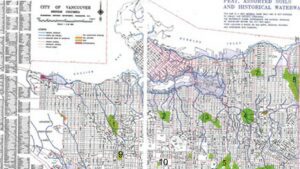About Peat Bogs in Vancouver when it comes to Real Estate
Have you ever been driving through East Van and noticed that the houses seem to have a  quirky angle to them? Or the sidewalks look like they are sinking? If so you have probably experienced Vancouver’s peat bog areas. These peat bogs came about as swampy areas were blocked and eventually drained to resemble solid ground. In a growing city such as Vancouver, these areas quickly became building ground for the expanding housing needs as the areas were often less expensive to build. Builds went up until around 1960 with little to anchor them. Over time the shifting and sinking ground has made for tilted floors and wonky fence lines. Ask any owner of a home in these areas – when they drop something on the floor, they know where it is going to end up. The bog areas are a constant project for city engineers as they try to keep sewer lines from sinking and sidewalks from cracking – even testing out rubber sidewalks on 17th ave!
quirky angle to them? Or the sidewalks look like they are sinking? If so you have probably experienced Vancouver’s peat bog areas. These peat bogs came about as swampy areas were blocked and eventually drained to resemble solid ground. In a growing city such as Vancouver, these areas quickly became building ground for the expanding housing needs as the areas were often less expensive to build. Builds went up until around 1960 with little to anchor them. Over time the shifting and sinking ground has made for tilted floors and wonky fence lines. Ask any owner of a home in these areas – when they drop something on the floor, they know where it is going to end up. The bog areas are a constant project for city engineers as they try to keep sewer lines from sinking and sidewalks from cracking – even testing out rubber sidewalks on 17th ave!
The Trout Lake community is one of these such areas. Trout lake originally served as a water supply for the mills until 1860. The higher acidity of the lake meant the boilers didn’t have to be cleaned as often but beavers often damned the water supply to the lake. Following world war two. it was one of East Vans only beaches. While the lake represents a thriving community today, the areas surrounding due to the work of those beavers have become the peat bog areas. These areas are now one of Vancouver’s many quirks and add character to the city!
As a home owner it is important to be aware of these areas and take action to stabilize your home. Cement pilings may be needed down to 16+ feet. Ensuring you get adequate testing done if you are looking to do a new build can prevent many sideways headaches in the future. In this case if the price tag seems too good to be true, it probably is. Work with a realtor who is familiar with the bog areas, and spend the extra money to ensure the house is stable before making an offer. Also familiarize yourself with city requirements when building or buying in these areas, they may require extra testing, soil samples and safety reports. Screw piles can be a good option for securing the foundation in areas where the peat is very thick, shallower areas can be excavated and filled with more stable foundation material.
Don’t let peat get you down – Vancouver’s most vibrant neighborhoods are built on peat bogs and with adequate knowledge and caretaking investing in these areas doesn’t have to leave your home as wonky as the roads.
—
For more information on real estate market in Vancouver, current trends, buying a home or selling a home, contact Leo Wilk – Your Top Vancouver Realtor.
— Don’t forget to follow Leo Wilk on Facebook | Twitter | Youtube | Instagram
